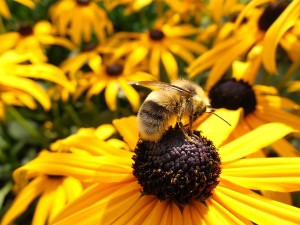 Let’s kick off May by focusing on the “little” workers in our gardens…
Let’s kick off May by focusing on the “little” workers in our gardens…
If you want to have a productive garden, you must remember that bees, butterflies, and other pollinators need our help to carry on their good work in our gardens. Let me introduce you to the pollinators that help produce your food…
Native Bees – more than 4,000 species, including the bumblebee, mason bee, and leafcutter bee. Each has a specialized pollinating job. Unlike social honeybees, most native bees are solitary, nesting in the ground or in holes. There is a myth that all bees sting, but the truth is that bees are focused on foraging for nectar, not harassing you. Bumblebees and other natives are naturally passive – only our own aggression will provoke a sting.
Honeybees – These hive dwellers were imported from Europe in the early 1600s to pollinate crops, including fruits, vegetables, and nuts. We rely on them for honey, too. They are attracted to white, yellow, and blue flowers/blossoms of all shapes and sizes.
Moths – Moths take over at dusk for the night shift while the rest are napping. Geometer moths, hummingbird moths, hawk moths, and many others search for fragrant night bloomers in white or pale colors that reflect moonlight.
Butterflies – Monarch, swallowtail, fritillary, painted lady, Sulphur – and the list goes on. Bees work more efficiently, but these leisurely flutterers turn food-driven flights into an aerial art form, landing on bright red, orange, yellow, and purple flowers/blossoms.
Flies – Not the common housefly we swat, but a respectable society of gentle bee mimics, including hoverfly, flower fly, and midge. They go for the less glamorous flowers/blossoms that others pass by.
For a list of the tasks that you need to work on in the garden, refer to Spring Gardening Tips: May Action List, May 11, 2015 in our archives.